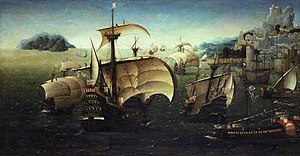
Back Armades de l'Índia Catalan Portugiesische Indien-Armadas German Hindiaj flotegoj de Portugalio Esperanto Armadas de la India Spanish Armata d'India Italian Indische armada Dutch Armadas da Índia Portuguese Индийские армады Russian
This article includes a list of general references, but it lacks sufficient corresponding inline citations. (August 2012) |

The Portuguese Indian Armadas (Portuguese: Armadas da Índia; meaning "Armadas of India") were the fleets of ships funded by the Crown of Portugal, and dispatched on an annual basis from Portugal to India. The principal destination was Goa, and previously Cochin. These armadas undertook the Carreira da Índia ('India Run') from Portugal, following the maritime discovery of the Cape route, to the Indian subcontinent by Vasco da Gama in 1497–99.
The annual Portuguese India armada was the main carrier of the spice trade between Europe and Asia during the 16th Century. The Portuguese monopoly on the Cape route was maintained for a century, until it was breached by Dutch and English competition in the early 1600s. The Portuguese India armadas declined in importance thereafter. During the Dutch occupation of Cochin and the Dutch siege of Goa, the harbour of Bom Bahia, now known as Mumbai (Bombay), off the coast of the northern Konkan region, served as the standard diversion for the armadas.
© MMXXIII Rich X Search. We shall prevail. All rights reserved. Rich X Search